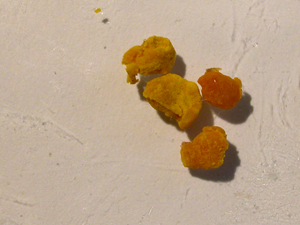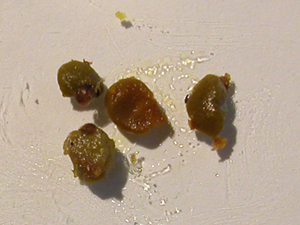 Spring has continued its early arrival in these parts with an 85 degree F day, which I celebrated by pulling the sliding panels out from the screened bottom boards of the hives. This gives the honeybees additional ventilation, and I get to look at what's been falling through lately. They also don't care at all about this operation, and are not disrupted in the least.
Spring has continued its early arrival in these parts with an 85 degree F day, which I celebrated by pulling the sliding panels out from the screened bottom boards of the hives. This gives the honeybees additional ventilation, and I get to look at what's been falling through lately. They also don't care at all about this operation, and are not disrupted in the least.I was supposed to do a mite count on Friday, but I forgot, so I just poked through the stuff on the panels in order to find pollen packs. These are the multicolored lumps that the bees pack onto the pollen baskets on their rear legs, and they give a good idea of what the bees have been up to. The picture above is maple pollen, deduced from blooming information at www.pollen.com and the knowledge that maple pollen is a lovely golden yellow. The bees get pollen all over their furry little selves, and they use their front and middle legs to comb it back, mix it with some nectar (to make it stick), and pack it on their back legs. That rounded shape is actually the largest arc that can be described by a bee arm: it's a more graceful shape than what we manage when we attempt to soap our own backs. The biggest pack here is about 2mm by 4mm, and things are looking a little greasy because of the oil on the bottom board. The pollen packs are also easy to squash, and have deformed a little.
 This olive drab stuff is willow pollen, apparently a far less desirable product, according to beekeepers. The bees seem to think it's OK. The Twain colony had a lot of maple on the bottom board, while Wilde had almost all of the willow. This may only mean that the Wilde girls filled up the cells with willow before working on maple, or it might mean nothing at all.
This olive drab stuff is willow pollen, apparently a far less desirable product, according to beekeepers. The bees seem to think it's OK. The Twain colony had a lot of maple on the bottom board, while Wilde had almost all of the willow. This may only mean that the Wilde girls filled up the cells with willow before working on maple, or it might mean nothing at all. The pollen-bearing field bees actually fly into the hive, back into a cell, and scrape the stuff off themselves. They pack only one kind of pollen in a cell, apparently, just like they collect only one kind of plant material on any single flight. The pollen packs that fall down are probably the result of misses, miscalculations, or overfilling. This whole business is a lot different from the way they handle nectar. When delivering flower juice, field bees find a house bee, give the nectar to her, and then fly away again.
I've been messing with the bees too much lately, but it's a bit of a conundrum. There's a risk of swarming, which means I should be checking or intervening, but I've been fiddling too much, which may endanger the colony. So I am sitting tight, watching pollen, and planning a cursory visit tomorrow.
There may be other visitors this week, however! My north side neighbor told me that her roof will be replaced one day this week, and she would call when she knows which day – purportedly because the dogs might be barky as a result. From the way she introduced the topic, I suspect that she knows! But she is a good person, and it makes me sad not to share this with her. Nonetheless, this is a great time of year for such a project, because the bees are in a good mood and it is not impossible or terrible to block them in their hives for a day, especially if it's a bit cooler than today. If anything, I want to meet the contractor who can guarantee a complete roof replacement in one day!
4 comments:
Just performed a quick "how are we doing?" check on both colonies. The key questions were:
— Is Wilde preparing to swarm?
— Did I mess up Wednesday's reversing of Twain?
— Is a major nectar flow starting, requiring me to add supers or extract from existing honey stores right away? and;
— What's the food situation for both colonies?
The answers are: no swarm cells in Wilde, Twain fixed my mistake quite remarkably (they extended the cluster across the empty frames and moved honey around it), there is some new nectar...but not much, and there's still plenty of food in the right spots for both colonies– though Wilde has somewhat less.
So, all good.
hi there-
i would love to email you but i have been unsuccessful through the site (tech not my strong suit). i have been keeping bees in a city for a few years now. i am appreciating your site very much.
best-
dayna
thousandflowerhoney@yahoo.com
Great blog. I'm a new beekeeper and feel like I'm over my head. I checked my hive and found 2 queen cells and do not know what to do next. Now I'm waiting for another nice day to go back and do a better check.
Any advice??
Hey Ava -- if you like, you can email me at phang@tonitoni.org anytime.
I consider myself a new beekeeper, too, and can totally relate to the overwhelmed feelings. I have just been dealing with something similar, too. But just a few ideas:
First of all, are your hives new, or have you just completed wintering them over? (if yes, congratulations!) In established colonies, the bees often make a few "queen cups" on the bottom of frames, it seems like a "just in case" thing: they don't intend to swarm. If you have a full and CAPPED queen cell, however, they could be about to do so. You still have a queen in this case, probably.
If there is a queen cell poking out from the middle of the frame, that's a supercedure cell, and you may not have a queen in there, or she may be failing. This might not indicate a swarm.
Drone cells fooled me the first time I saw them: they poke out farther than the usual capped worker cells, but don't mean anything bad.
You can see pictures of queen cells here:
These are "supercedure" cells
http://www.beemaster.com/honeybee/qpage.htm
http://www.ccdemo.info/GardenBees/WorkingTheHive/QueenCellSpur300Wx384H.jpg
These are "swarm" cells:
http://www.beesource.com/eob/4dot9/swarmcell.htm
http://www.three-peaks.net/bee_life.htm
http://www.okbees.org/images/everett/Queen%20cup.jpg
If you look at that last picture, you can see some drone cells further up on the frame.
This picture is of drone cells from my own colony: some of them broke when I pulled the frame:
http://www.tonitoni.org/images/050501_emcellquest1.jpg
This is a picture of drone brood mixed with worker brood:
http://www.bindaree.com.au/images/nlsep05_1.jpg
Sorry this is so long. It's fine to email me with more details if this is all off base!
Cheers!
Post a Comment